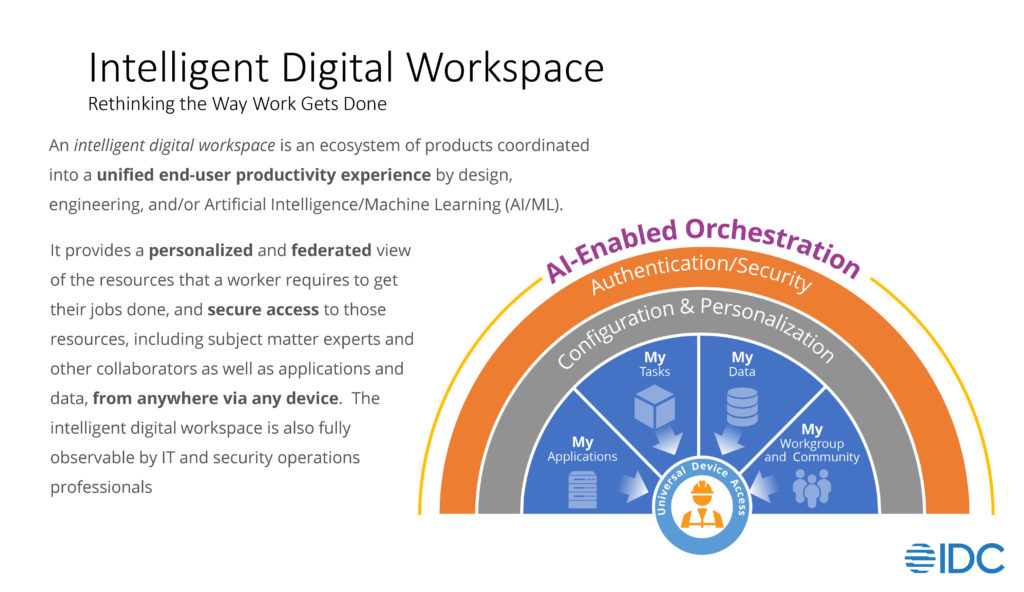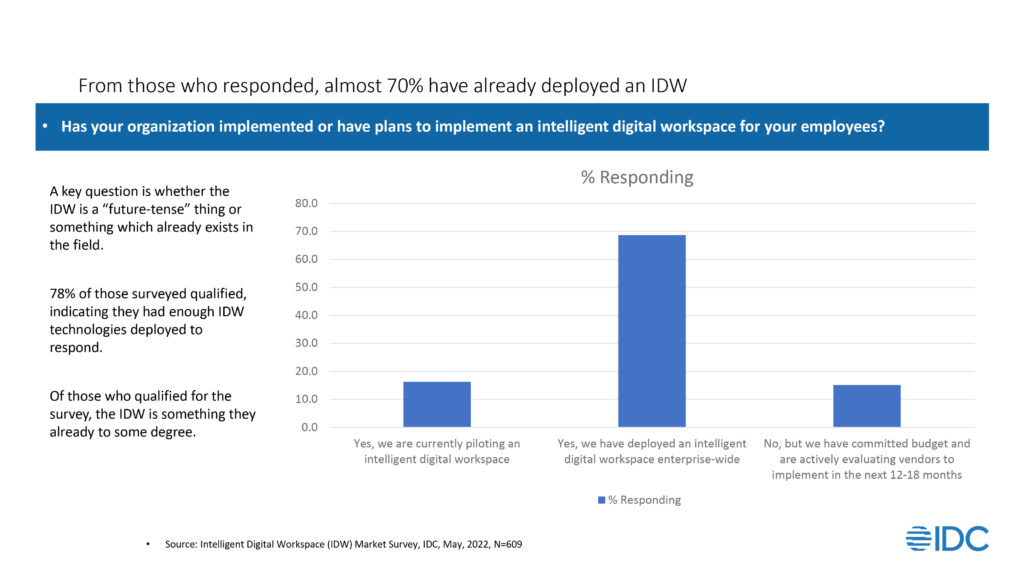Let’s start with a question.
When was the last time you picked up a phone to call a coworker?
Odds are, it was a while ago. Instead, you reached out through Teams or Slack, email or a workflow of some kind. You might have pushed a task to them through a service portal or used an analytics tool to give them data. And you probably didn’t think anything of it. Maybe you used Dall-E to create a custom meme then folded it into fluid document.
Each of these scenarios, and many more, are components of what IDC calls the “Intelligent Digital Workspace” (IDW). Well, we actually call it an “intelligent digital workspace ecosystem”, which is a phrase intended to convey:
- Intelligent – the environment uses AI/ML and scripted automation to adapt to the user’s requirements
- Digital – the environment coordinates electronics and software both local to the user and remote to them to meet the user’s needs
- Workspace – the environment is used to do work, as opposed to, say, playing games
- Ecosystem – the environment is deliberately constructed of many components (data, electronics, software, and more) which work together in a coordinated fashion

If we ask people directly if they have deployed an “intelligent digital workspace ecosystem”, not many respond positively. But, if instead we look at the functions of such an ecosystem, we see that over 70% of companies have enough functions to say they have already deployed it.

How did we get here?
So, how did we end up deploying an entirely new operational concept of the workspace without, well, noticing? Did vendors trick us into it? Was it the result of a Friday night that we just, collectively, don’t quite remember but photos ended up online?
Honestly, like any technical ecosystem, the IDW concept emerged in response to the collective efforts of tens of thousands of companies to provide employees relief from:
- Inefficient or manual processes
- Switching between applications to support those processes
- The barriers to entry (time, authentication steps, etc.,) introduced by security protocols (Intelligent Digital Workplace Survey, April 2022)
As we all struggled to adapt to these challenges, we also discovered that those inefficient processes and the technical challenges with the applications supporting those processes spurred further issues. Teams became increasingly isolated within themselves. IT support simply could not respond quickly enough and small problems lingered for hours or days. Security systems designed for on-premise use, or to protect systems for occasional remote work, were untenably obscure and difficult to use over an extended period of time.
So, of course, we fixed it.
We deployed management tools which helped smooth out end user security (1st ranked IDW management tool) and operations. These tools came from major vendors and small players, grew up in-house and evolved quickly to meet our expanded needs.
We deployed team collaboration and workflow tools to connect employees (1st and 2nd ranked IDW end-user argumentation).
We deployed intelligent service management to provide support (2nd ranked workspace integration) with cross-group collaboration and the ability to report on activity across teams and the enterprise being the two most important attributes we designed for.
When it wasn’t enough, we empowered our teams to develop their own solutions and deployed those enterprise wide, accomplishing more for “agile transformation” in two years than we did in the previous two decades.
What’s Next?
Although we did well, solving those problems brought with it a host of new opportunities. The results are often extremely complex, interweaving systems never really intended to work together. Each enterprise has to manage the complexity on their own, and frankly they seem tired of it. Now over 75% of organizations say that management and maintenance of this elaborate ecosystem is the responsibility of the vendors not the enterprise.
This is, in part, because the world does not stand still. The seemingly impossible challenges of allowing people to work in a dispersed, hybrid environment have given way in the hierarchy of problems to questions of geopolitical instability, to a collapsing return on energy investment for fossil fuels, and labor-shortages/job shuffling across a broad demographic range. These pressures will only continue – with storms of disruption sweeping through the technology industry. Simply put, enterprises will expect their vendors to step up and manage these ecosystems because the IT staff will have other things to do.
Meeting these “other things” will require the enterprise to clarify how it intends to use the IDW and for chosen platform vendors to respond, allowing employees for all enterprises to deliver faster, more consistently, and with greater productivity than traditionally organized and supported teams.
Now What?
So, that’s a lot. We de facto created a new kind of digital workspace, founded in a wide range of technologies ranging from virtualization and endpoint management on one side to enterprise portals and content management on the other. We cannot spend the time to manage the complexity of it anymore, so will turn to outside vendors and AI/ML to reduce operational load. So, what do we do about it?
The question isn’t if you have an IDW; it’s whether you are actively coordinating it to deliver the right outcomes.
Advice for the enterprise: Enterprises need to step back and assess their existing environments. Many will find that they have, de facto, deployed elements of an intelligent digital workspace as part of their ongoing efforts. Those that have deployed the IDW de facto need to rapidly fill in any missing capabilities and work with their existing vendors to get out from under the operational burden the new environment creates. Those that for whatever reason, lagged behind need to move quickly, coordinating with new or emerging vendors to deploy enough capabilities to support new ways of working.
Advice for the vendors: Vendors need to stop and assess their current offerings in terms of where they fit into the intelligent digital workspace ecosystem. Coordination with partners, the ability to quickly solve emerging problems, and lowering operational burdens are likely to be the key messages customers need to hear over the next 12 to 18 months. Many companies will also look for AI/ML enabled support and operations services, as well as the ability to deploy AI/ML models to support their employees.
The IDW is now a permanent feature of the enterprise. It will, whether we think about it or not, continue to expand. By being intentional and focused, enterprises and their vendor partners can derive the best value from this evolving ecosystem, shaping it to their needs.




